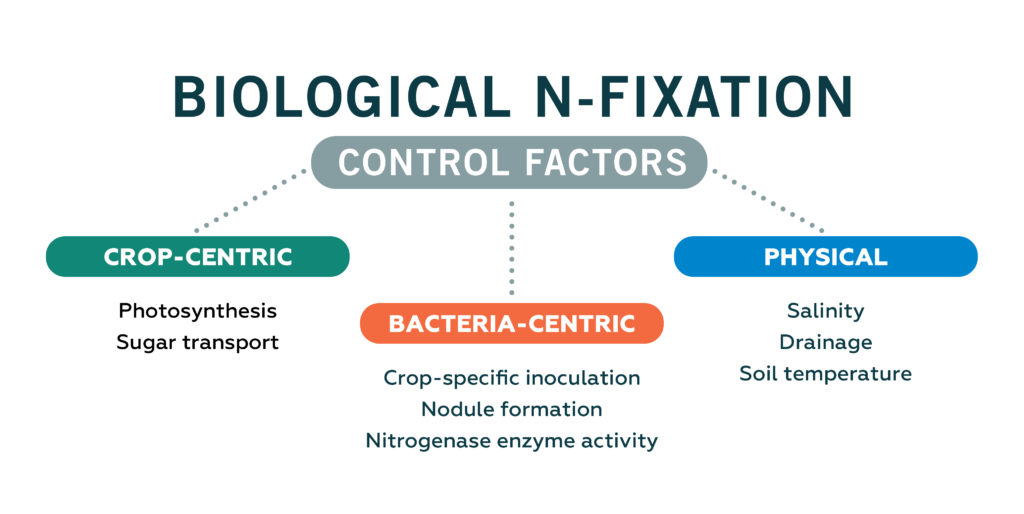Apr 11, 2025

Nutrient management is an important part of every growing season, regardless of region or crop. Nitrogen, phosphorus, and potassium (NPK) are the fundamental nutrients essential to plant nutrition and supporting a grower’s yield goals. Of these three, nitrogen is the building block of growth, supporting protein formation and the production of new shoots and roots. Nitrogen is also an important component of chlorophyll, which is essential for turning sunlight energy into plant biomass (photosynthesis).
However, nitrogen is often the most limiting nutrient for crop yield globally. One challenge with nitrogen is that biologically useful nitrogen is hard to come by in the soil. Many growers typically address this challenge by adding fertilizers to help crops get the N they can’t access in the soil. Some crops, such as legumes, have developed their own interesting solution to the nitrogen problem. These crops solve nitrogen limitation by going into partnership with a special group of bacteria called Bradyrhizobia. These bacteria pull nitrogen from the air and turn it into a form that can be used by plants. Legume crops “pay” the bacteria for the nitrogen with sugar and allow the bacteria to form nodules in the roots to help protect the Bradyrhizobia.
Nitrogen fixation, or N-fixation, is the chemical process of taking nitrogen gas and turning it into ammonia or other bio-available nitrogenous compounds, which are used by plants to grow and thrive.
This process is just as complicated as it sounds! Nitrogen gas is all around us, but in a form that is inaccessible to most living things. If you remember from chemistry class (or even if you don’t!) nitrogen has a triple-covalent bond, which is hard to break down into useable parts. However, thanks to the miracle of nature, there are some bacteria that can break down nitrogen into components that plants thrive on.
Rhizobia are microorganisms that live in the soil and work together with plants to grow. Rhizobia are a diverse species and are extremely particular about which crop they partner with. For example, the rhizobia strain that helps clover use nitrogen is not the same as the rhizobia strain that help legumes, like soybeans or peanuts, use nitrogen. Even among legumes, there isn’t a “one-size-fits-all” strain of rhizobia that partners with all legumes. Rhizobia strains are extremely plant-specific, which is why, for example, you couldn’t successfully use soybean inoculant on peanuts, or vice versa. Plants and their corresponding rhizobia are like puzzle pieces – you must combine the right pair to see results.
The likelihood of a plant finding the perfect match of rhizobia to help it grow, out of the billions of microorganisms that randomly live in the soil, can be a long shot. This is where inoculation comes in – to put the odds in favor of the grower and the crop for a successful yield.
Inoculation is the act of adding a specific, live rhizobia to the seed or the soil with the goal of promoting improved N-fixation during the growing season. These rhizobia “infect” the roots as they grow from the seed, creating nodules – essentially little “homes” for the rhizobia to live and thrive in. Once surrounded by the nodule, the bacteria start pulling nitrogen into the root and converting into something the plant can use. Inoculation creates a perfect match for the crop by adding the exact bacteria that work to bring nitrogen to the plant to help it grow. This nitrogen accumulation has a direct positive correlation to yield.
N-fixation through inoculation can help growers improve nitrogen use efficiency (NUE), increase yield, and eventually return nitrogen to the field at harvest to recycle for another season.
How does PhycoTerra support successful inoculation?
In addition to choosing the right rhizobia strain for your crop, there are several factors that affect N-fixation. PhycoTerra products can help create an environment that supports successful N-fixation.

Crop-centric factors are also supported by the activated microbes. As the microbes improve soil health, they also improve plant performance, which allows the plant to develop more energy or “currency” to pay for N-fixation earlier. A healthy crop has more resources and a better ability to “pay” for more biological N-fixation relative to an unhealthy crop.
While inoculants take center stage as the main bacteria-centric factor, our award-winning seed treatment, PhycoTerra ST, complements inoculants to provide greater overall results for growers.
PhycoTerra ST is a unique seed treatment that adds a high-quality carbon source to the seed. Microorganisms “follow the food” so the extra carbon allows the seed to recruit more microbial partners after planting.
Living Bradyrhizobia are sensitive and can’t be mixed with many things, e.g., fertilizer, but PhycoTerra ST is inert and has excellent mixability with most seed treatments and liquid in-field inputs, including inoculants. In field trials with several soybean inoculants, when PhycoTerra ST went out on the seed with the inoculant, the combination of the two inputs outperformed both the control and inoculant alone. Adding PhycoTerra ST in addition to the inoculant yielded +5 bushels an acre, more than doubling the +2.3-bushel increase with inoculant alone. ROI increased from 6:1 to 10:1.*

Sustainable, biological inputs like inoculants are on the rise – want to learn more?
Brush up on the many biostimulants available in the market today and what they can do for your crops with Dr. Karl’s article for Progressive Crop Consultant.
Note: All trial data is current as of blog posting. For the most up to date trail data, please visit our trials page.